 I spoke at The Data Summit last week and gave a room full of technology experts a by-the-numbers tour of the UK film industry. It’s always fun to give non-industry people a glimpse into the film industry as it’s a healthy reminder just how bizarre some of our practises are. I spoke to the accompaniment of sharp intakes of breaths (at the chronic mis-match between supply and demand), the sound of jaws dropping (at the success rate of films) and even a heckle of support from The Guardian’s technology editor Charles Arthur (when discussing the “originality” of Hollywood films). One question that came from two different people was: What does it cost to make a film in Britain? So I thought I’d look at this on my blog this week. The numbers below relate to films shot in the UK, as defined by the BFI. In summary…
I spoke at The Data Summit last week and gave a room full of technology experts a by-the-numbers tour of the UK film industry. It’s always fun to give non-industry people a glimpse into the film industry as it’s a healthy reminder just how bizarre some of our practises are. I spoke to the accompaniment of sharp intakes of breaths (at the chronic mis-match between supply and demand), the sound of jaws dropping (at the success rate of films) and even a heckle of support from The Guardian’s technology editor Charles Arthur (when discussing the “originality” of Hollywood films). One question that came from two different people was: What does it cost to make a film in Britain? So I thought I’d look at this on my blog this week. The numbers below relate to films shot in the UK, as defined by the BFI. In summary…
- Across all films shot in the UK in 2013, the average film budget was £6.2 million.
- Adjusted to 2013 pounds, the average film budget in 2012 was £4.2 million, 2011 was £7m, 2010 was £5.4m and 2009 was £6.9m.
- 43% of films shot in the UK in 2013 cost less than £500,000
- All of those <£500k films account for only 4% of all money spent on films in 2013.
- The average film budget for <£500k films in 2013 was £150,000
The overall average film budget
The average film budget for all films shot in the UK in 2013 was £6.2 million. 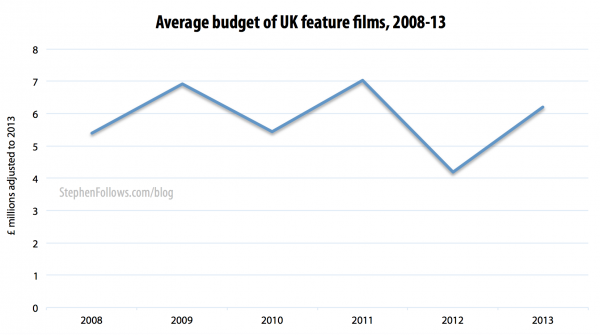 This is not very revealing as there are so many different types of films made in the UK that it’s akin to asking what the average cost of a restaurant meal is – it depends what you’re eating.
This is not very revealing as there are so many different types of films made in the UK that it’s akin to asking what the average cost of a restaurant meal is – it depends what you’re eating.
Drilling Deeper – The Films We Make
In order to uncover a more useful answer we should start by looking at the types of films we make in the UK. By number, two thirds are budgeted under £2 million. 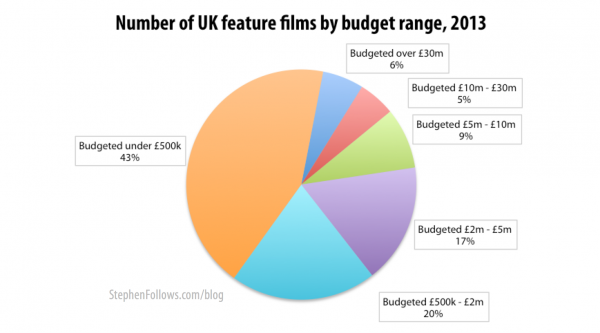 But when we look at the amount of money spent we can see that these low budget films make up just 13% of the overall spend.
But when we look at the amount of money spent we can see that these low budget films make up just 13% of the overall spend. 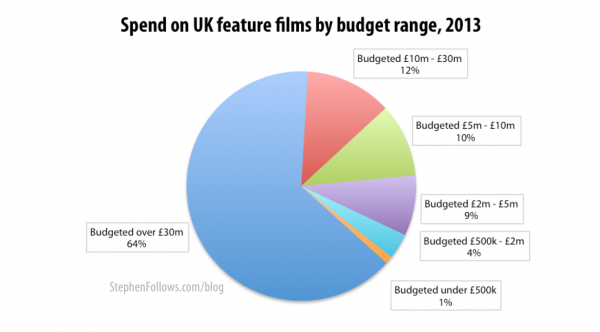 So it’s clear that stating one average film budget across all films is not very useful.
So it’s clear that stating one average film budget across all films is not very useful.
Average film budget by budget range
With this in mind, I grouped the films into six budget ranges and calculated the inflation-adjusted average budgets. 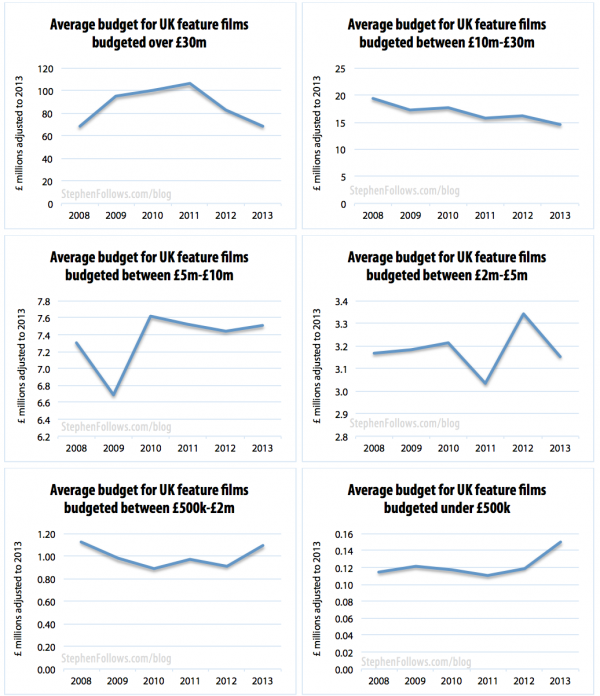 The final chart is of particular interest. With most of the other graphs the average film budget is towards the middle of the range; such as the “£10m – £30m” range where the average in 2013 was £14.6m. However, in the “Under £500k” range we can see that the 2013 average is just £150k. This suggests that further segmentation is needed at this lower level to reveal more (sadly that data is not yet available).
The final chart is of particular interest. With most of the other graphs the average film budget is towards the middle of the range; such as the “£10m – £30m” range where the average in 2013 was £14.6m. However, in the “Under £500k” range we can see that the 2013 average is just £150k. This suggests that further segmentation is needed at this lower level to reveal more (sadly that data is not yet available).
Methodology
The initial data points came from the BFI’s Research and Statistics Unit. From there I extrapolated some data, combined with others and adjusted for inflation. I chose to focus on films shot in the UK as defined by their production year. An alternative course open to me was to study the films passing the Cultural Test. This was a slightly smaller number of films, so I opted to study production over certification. In a future blog I may return to this topic as in some cases the number of films made in the UK differs significantly from the number of films passing the Cultural Test. I feel there is something of interest to be teased out of these differences. Stay tuned, campers.


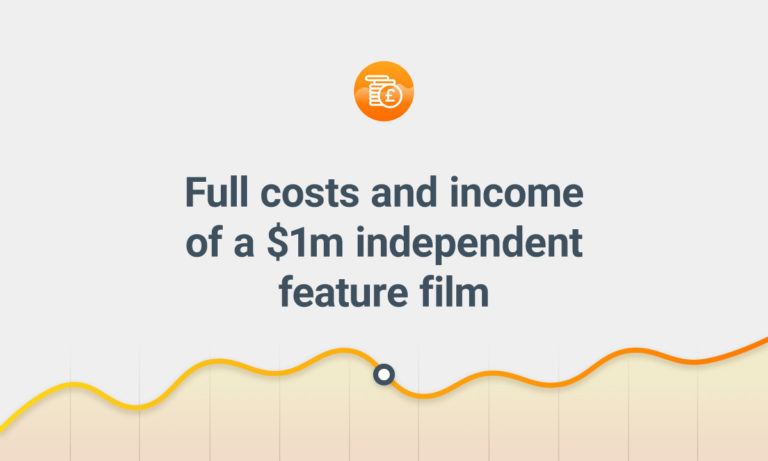


Comments
Excellent and detailed analysis. Thanks Stephen!
What I’d like to see is box office and returns breakdown according to genre etc in the under 500K bracket. That would be interesting . . . for me.
nice work!
very interested in how these statistics look when separated between domestically invested and inwardly invested films (US production companies). is this possible with your data?